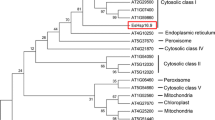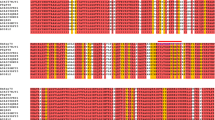Abstract
In industrial fermentation of yeast (Saccharomyces cerevisiae), culture conditions are often modified from the optimal growth conditions of the cells to maintain large-scale cultures and/or to increase recombinant protein production. However, altered growth conditions can be stressful to yeast cells resulting in reduced cell growth and viability. In this study, a small heat shock protein gene from carrot (Daucus carota L.), Hsp17.7, was inserted into the yeast genome via homologous recombination to increase tolerance to stress conditions that can occur during industrial culture. A DNA construct, Translational elongation factor gene promoter—carrot Hsp17.7 gene—Phosphoribosyl-anthranilate isomerase gene (an auxotrophic marker), was generated by a series of PCRs and introduced into the chromosome IV of the yeast genome. Immunoblot analysis showed that carrot Hsp17.7 accumulated in the transformed yeast cell lines. Growth rates and cell viability of these cell lines were higher than control cell lines under heat, cold, acid, and hyperosmotic stress conditions. Soluble protein levels were higher in the transgenic cell lines than control cell lines under heat and cold conditions, suggesting the molecular chaperone function of the recombinant Hsp17.7. This study showed that a recombinant DNA construct containing a HSP gene from carrot was successfully expressed in yeast by homologous recombination and increased tolerances to abiotic stress conditions.



Similar content being viewed by others
References
Ahn Y, Song N (2012) A cytosolic heat shock protein expressed in carrot (Daucus carota L.) enhances cell viability under oxidative and osmotic stress conditions. HortScience 47:143–148
Ahn Y, Zimmerman JL (2006) Introduction of the carrot HSP17.7 into potato (Solanum tuberosum L.) enhances cellular membrane stability and tuberization in vitro. Plant Cell Environ 29:95–104
Basílio ACM, Araújo PRL, Morais JOF, Silva-Filho EA, de Morais MA Jr, Simões DA (2008) Detection and identification of wild yeast contaminants of the industrial fuel ethanol fermentation process. Curr Microbiol 56:322–326
Bentley NJ, Fitch IT, Tuite MF (1992) The small heat-shock protein Hsp26 of Saccharomyces cerevisiae assembles into a high molecular weight aggregate. Yeast 8:95–106
Bonander N, Bill MR (2012) Optimising yeast as a host for recombinant protein production. Methods MolBiol 866:1–9
Bradford MM (1976) A rapid and sensitive method for the quantitation of microgram quantities of protein utilizing the principle of protein-dye binding. Anal Biochem 72:248–254
Brosnan MP, Donnelly D, James TC, Bond U (2000) The stress response is repressed during fermentation in brewery strains of yeast. J Appl Microbiol 88:746–755
Conzelmann A, Riezman H, Desponds C, Bron C (1988) A major 125-kd membrane glycoprotein of Saccharomyces cerevisiae is attached to the lipid bilayer through an inositol-containing phospholipid. EMBO J 7:2233–2240
de Melo HF, Bonini BM, Thevelein J, Simões DA, Morais MA Jr (2009) Physiological and molecular analysis of the stress response of Saccharomyces cerevisiae imposed by strong inorganic acid with implication to industrial fermentations. J Appl Microbiol 109:116–127
Gasser B, Saloheimo M, Rinas U, Dragosits M, Rodríguez-Carmona E, Baumann K, Giuliani M, Parrilli E, Branduardi P, Lang C, Porro D, Ferrer P, Tutino ML, Mattanovich D, Villaverde A (2008) Protein folding and conformational stress in microbial cells producing recombinant proteins: a host comparative overview. Microb Cell Fact 7:11
Gatignol A, Dassain M, Tiraby G (1990) Cloning of Saccharomyces cerevisiae promoters using a probe vector based on phleomycin resistance. Gene 91:35–41
Gietz RD, Schiestl RH (2007) High-efficiency yeast transformation using the LiAc/SS carrier DNA/PEG method. Nat Protoc 2:31–34
Hohmann S (2002) Osmotic stress signaling and osmoadaptation in yeast. Microbiol Mol Biol Rev 66:300–372
Jahic M, Veide A, Charoenrat T, Teeri T, Enfors SO (2006) Process technology for production and recovery of heterologous proteins with Pichia pastoris. Biotechnol Prog 22:1465–1473
Jiang C, Xu J, Zhang H, Zhang X, Shi J, Li M, Ming F (2009) A cytosolic class I small heat shock protein, RcHSP17.8, of Rosa chinensis confers resistance to a variety of stresses to Escherichia coli, yeast and Arabidopsis thaliana. Plant Cell Environ 32:1046–1059
Kim H, Ahn Y (2009) Expression of a gene encoding the carrot HSP17.7 in Escherichia coli enhances cell viability and protein solubility under heat stress. HortScience 44:866–869
Kitagawa M, Miyakawa M, Matsumura Y, Tsuchido T (2002) Escherichia coli small heat shock proteins, IbpA and IbpB, protect enzymes from inactivation by heat and oxidants. Eur J Biochem 269:2907–2917
Kregel KC (2002) Invited review: heat shock proteins: modifying factors in physiological stress responses and acquired thermotolerance. J Appl Physiol 92:2177–2186
Malik MK, Slovin JP, Hwang CH, Zimmerman JL (1999) Modified expression ofa carrot small heat shock protein gene, Hsp17.7, results in increased or decreased thermotolerance. Plant J 20:89–99
Mattanovich D, Gasser B, Hohenblum H, Sauer M (2004) Stress in recombinant protein producing yeasts. J Biotechnol 113:121–135
Pacheco A, Pereira C, Almeida MJ, Sousa MJ (2009) Small heat-shock protein Hsp12 contributes to yeast tolerance to freezing stress. Microbiology 155:2021–2028
Park H, Ahn Y (2016) Development of transgenic Escherichia coli with improved viability by heterologous expression of a heat shock protein gene from carrot (Daucus carota L.). HortScience 51:305–310
Piper PW, Ortiz-Calderon C, Holyoak C, Coote P, Cole M (1997) Hsp30, the integral plasma membrane heat shock protein of Saccharomyces cerevisiae, is a stress-inducible regulator of plasma membrane H(+)-ATPase. Cell Stress Chaperon 2:12–24
Rao MB, Tanksale AM, Ghatge MS, Deshpande VV (1998) Molecular and biotechnological aspects of microbial proteases. Microbiol Mol Biol Rev 62:597–635
Rosano GL, Ceccarelli EA (2014) Recombinant protein expression in Escherichia coli: advances and challenges. Front Microbiol 5:172
Saito H, Posas F (2012) Response to hyperosmotic stress. Genetics 192:289–318
Tiwari S, Thakur R, Shankar J (2015) Role of heat-shock proteins in cellular function and in the biology of fungi. Biotechnol Res Int 2015: Article ID 132635
van Leeuwen J, Andrews B, Boone C, Tan G (2015) Rapid and efficient plasmid construction by homologous recombination in yeast. Cold Spring Harb Protoc 9:853–861
Varela JC, Praekelt UM, Meacock PA, Planta RJ, Mager WH (1995) The Saccharomyces cerevisiae HSP12 gene is activated by the high-osmolarity glycerol pathway and negatively regulated by protein kinase A. Mol Cell Biol 15:6232–6245
Verghese J, Abrams J, Wang Y, Moranoa KA (2012) Biology of the heat shock response and protein chaperones: budding yeast (Saccharomyces cerevisiae) as a model system. Microbiol Mol Biol Rev 76:115–158
Vierling E (1991) The Roles of Heat Shock Proteins in Plants. Annu Rev Plant Biol 42:579–620
Wang W, Vinocur B, Shoseyov O, Altman A (2004) Role of plant heat-shock proteins and molecular chaperones in the abiotic stress response. Trends Plant Sci 9:244–252
Xue Y, Peng R, Xiong A, Li X, Zha D, Yao Q (2009) Yeast heat-shock protein gene HSP26 enhances freezing tolerance in Arabidopsis. J Plant Physiol 166:844–850
Acknowledgements
This research was supported by Basic Science Research Program through the National Research Foundation of Korea (NRF) funded by the Ministry of Science, ICT & Future Planning (2015R1C1A2A01053040).
Author information
Authors and Affiliations
Corresponding author
Ethics declarations
Conflict of interest
The authors declare that there is no conflict of interest related to this study.
Electronic supplementary material
Below is the link to the electronic supplementary material.
Rights and permissions
About this article
Cite this article
Ko, E., Kim, M., Park, Y. et al. Heterologous Expression of the Carrot Hsp17.7 gene Increased Growth, Cell Viability, and Protein Solubility in Transformed Yeast (Saccharomyces cerevisiae) under Heat, Cold, Acid, and Osmotic Stress Conditions. Curr Microbiol 74, 952–960 (2017). https://doi.org/10.1007/s00284-017-1269-z
Received:
Accepted:
Published:
Issue Date:
DOI: https://doi.org/10.1007/s00284-017-1269-z




